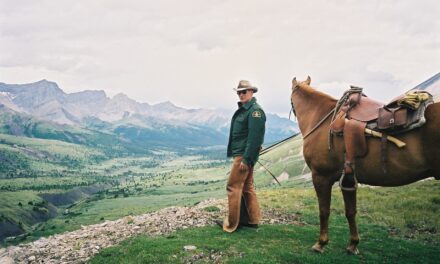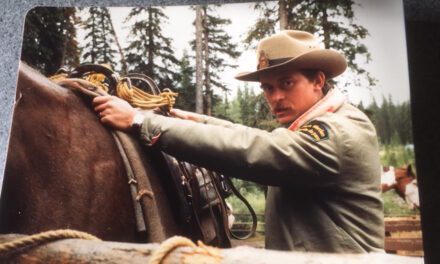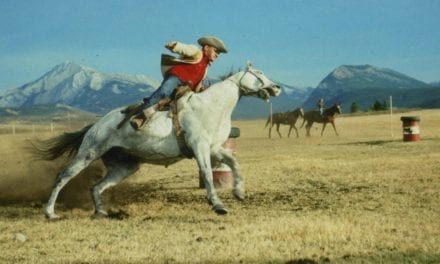SH: Funny. Okay what else you got?
Paul: Well rescue, like the slinging under the helicopter when that was first getting going. We were training for that stuff. It was pretty interesting but I thought it was great fun. The first day we were ever doing it, there was a bunch of us, and it was in Banff down by the Spray River. We were up at the quarry there. We were flying up under the back side of Rundle. There was quite a few of us going. Jim was flying us up one at a time. Jay Morton, he was nervous as hell. When he went to hook on to the carabiner in the rope, under the chopper there. He’s trying to hook the carabiner on his harness into the loop on rope rather than the carabiner on the rope itself. He got his carabiner jammed on the rope. It’s not closed actually, on the loop. It’s just sitting on the rope. Jim lifts him up and he’s staring at this thing and hanging onto the rope for all he was worth. But he got up there. Nothing happened, it was all good. Then the rest of us get there, and we’re doing some stuff there and then we’re going to come down. Jim is going to fly us down two at a time. So I said to Jay “Come on Morton, you and I will go.” He said “I’d rather walk … I don’t want to do this stuff.” I said, “Come on it’ll be nothing but fun.” So I talked him into it. We both hooked on and away we went. We were whipping along there, and I leaned back and was looking under the helicopter there. I said, “Look at that Morton, that’s pretty neat.” He said, “I don’t give a shit about that”. He’s still hanging on for dear life with both hands. Then we were getting down close to the river and I said to him “You know Jay, with us two being on the end of this rope, and Jim flying this machine, I wouldn’t doubt it if he just parks us in the middle of the river and we couldn’t do a thing about it. We come in there, and we come in right over top of the river, and he set us down over on the side, in the pit again, and he parked us there where he was supposed to go. I was laughing like hell.
Well actually after I was done with the wardens and I had the outfit and stuff going, I was at a show in Edmonton and Gerry Lyster stopped by my booth. He was living up that way then. He used to be the warden at Cyclone for years, and he was at Saskatchewan Crossing. He worked for the Warden Service for a long time. That was right when the bears were all … there were grizzly bears everywhere. They were having such a flip about them. Jerry was asking me, he came right in and we were sitting there having coffee in my booth and just talking, and he starts asking me about all these bears and stuff. I told him, some of those grizzly bears have more helicopter hours than the pilots flying them. Because that’s when they were flying them out. They’d tranquilize them, load them in the net and fly them out somewhere else.
He said “When I was a warden at the “Head of the Red”, I never had any problems. If I did have a problem, I took care of it. We never had any issues like that at all.” That was the way it worked then. I remember at the old cabin there, there was claw marks on the back wall on that cabin just about right to the peak.
SH: Which cabin was this?
Paul: The old Cyclone cabin at Red Deer Lakes. That’s where Gerry was for quite awhile. His headquarters and stuff. It was good times then. Rules were bent before you even started half the time.
We got on a search on Mount Rundle one time, Morton and I and someone else. We went to Banff, it might have been for a gymkhana meeting or something. But this search was getting organized. Some staff were missing up there from the Banff Springs. So we ended up getting conned into being part of this search party. We didn’t have any gear with us or nothing. But Walter says, “We got stuff in the rescue cache.” And they did have some pairs of climbing boots. You might find a pair that would half fit you, that kind of thing. But we got all decked out and a bunch of us rode some horses up the back side of Rundle on the trail in the evening and then we split up into different groups and everyone had bivy sacks to camp in when we decided it was time.
So we did that, and at night there was about three different groups searching and when it got really dark that was the end of that. So we all parked where we were and in the morning we were on the side of one of the big draws on the backside of Rundle and across it was another group. Joe Halstenson was over there, and I remember him standing up on the edge of the cliff there in his bright orange bivy sack and he starts crowing like a big raven, flapping his wings. We were all killing ourselves laughing at that. But they found the guys from the Banff Springs the next morning. They were huddled up in a bunch of rocks with their Ontario climbing gear on …. a t-shirt and a pair of shorts, freezing their asses off. It all came out in the wash, it was good.
But that’s about it for stories.
SH: I’m going to have to ask Marie if I can send your story to Larry. It’s so funny.
Paul: I’ll tell you a fish-stocking story with horses. We were going in with Bill Cable, who used to run the fish hatchery, and Wally McPhee, and Morton. I remember our old packhorse, he scraped along the side of a car when we were leaving. Wally said “Nobody saw that, let’s go!” You used to have special pack boxes to put the fish in, to pack them into all these lakes. We got to Consolation Lakes and we were putting them in there, and damned if Wally didn’t slip on the logs and fall on his ass into the lake. Everybody had a good laugh about that. But now we are spending hundreds of thousands of dollars to get rid of all them fish. What a bunch of horseshit. But at least it gives me something to remember. (Tape 20:35)

Near Paul’s camp at Red Deer Lakes. Photo courtesy of Susan Peyto.
End/sh
* * *
Susan Hairsine worked for Resource Conservation and Operations in Mt. Revelstoke/Glacier, Jasper and Banff National Parks, as well as for Public Safety in Western and Northern Region for over 30 years. She obtained funding for an oral history of Parks Canada’s avalanche personnel and oversaw the successful completion of the project. Her experience working with several the interviewees during their careers has been an asset to the current project. She was also the Executive Assistant to the Chief Park Wardens of Jasper and Banff National Parks.



